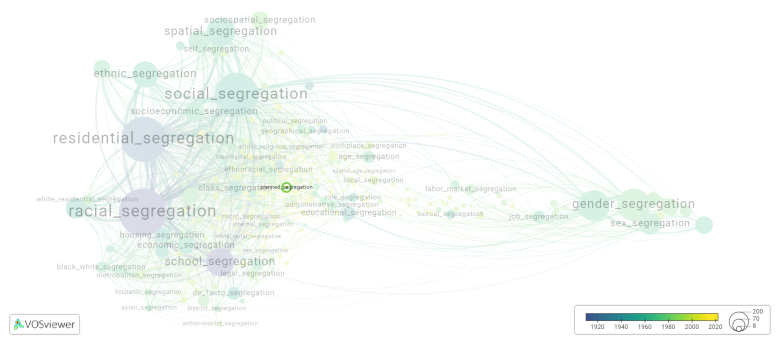Planned segregation: Difference between revisions
(Creating page) |
(Creating page) |
||
| Line 16: | Line 16: | ||
[[File:planned_segregation.png|780x780px]] | [[File:planned_segregation.png|780x780px]] | ||
This visualization is based on the study [[How_to_cite_Segregation_Wiki| The Multidisciplinary Landscape of Segregation Research]]. | |||
For the complete network of | For the complete network of interrelated segregation forms, please refer to: | ||
* | * [https://tinyurl.com/2235lkhw First year of publication] | ||
* | * [https://tinyurl.com/2d8wg5n3 Louvain clusters] | ||
* | * [https://tinyurl.com/223udk5r Betweenness centrality] | ||
* | * [https://tinyurl.com/244d8unz Disciplines in which segregation forms first emerged (Scopus database).] | ||
==References== | ==References== | ||
==Notes== | ==Notes== | ||
Revision as of 07:49, 10 October 2024
Date and country of first publication[1]
1997
Portugal
Definition
Planned segregation refers to the intentional separation and isolation of people based on certain characteristics, such as race, ethnicity, religion, or social class. This can be seen in various forms, such as the establishment of segregated neighborhoods, schools, public facilities, or transportation systems.
Historically, planned segregation has been employed as a tool to maintain power dynamics and reinforce social hierarchies. An infamous example is the Jim Crow laws in the United States, which enforced racial segregation between the 1870s and 1960s. These laws mandated separate facilities for Black and white individuals, denying Black Americans access to resources and opportunities available to white Americans.
However, the idea of planned segregation is widely condemned today due to its inherent discrimination and violation of human rights principles, such as equality and non-discrimination. Governments and societies now strive for integration and inclusivity, promoting diversity and equal access to resources and opportunities for all individuals, regardless of their demographic background.
See also
Related segregation forms
Planned segregation is frequently discussed in the literature with the following segregation forms:
This visualization is based on the study The Multidisciplinary Landscape of Segregation Research.
For the complete network of interrelated segregation forms, please refer to:
References
Notes
- ↑ Date and country of first publication as informed by the Scopus database (December 2023).
At its current state, this definition has been generated by a Large Language Model (LLM) so far without review by an independent researcher or a member of the curating team of segregation experts that keep the Segregation Wiki online. While we strive for accuracy, we cannot guarantee its reliability, completeness and timeliness. Please use this content with caution and verify information as needed. Also, feel free to improve on the definition as you see fit, including the use of references and other informational resources. We value your input in enhancing the quality and accuracy of the definitions of segregation forms collectively offered in the Segregation Wiki ©.
Planned segregation appears in the following literature
Madaleno I.M. (1997). Planned segregation: Cape Town and Brasilia. Geographia Polonica, 69(), 178-179. https://doi.org/

